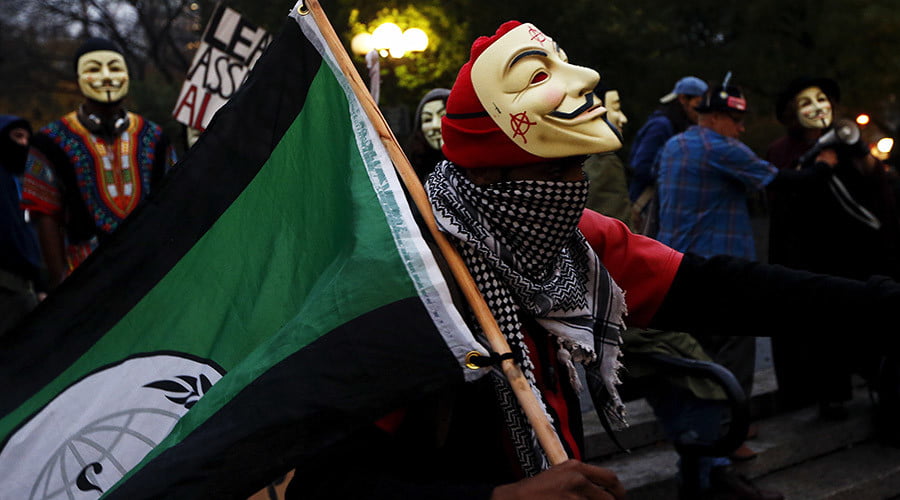is past July, an account called Cursed Images began posting a series of numbered photos, without commentary, on Twitter. An outstretched foot with lit cigarettes tucked between each toe was “cursed image 5927.” A man sitting on a pink couch with two enormous poodles, all three of them wearing birthday hats, was “cursed image 67.” Around three hundred photos have followed since then, and the cursed images have become increasingly unnerving: a gun pointed at a stuffed Barney (7447); lurid purple dish soap dripping over a waffle, like syrup (99); a woman playing the violin while doctors perform surgery on the back of her head (672); a child in a snowsuit with its head stuck in the barrel of a cannon (9972); an upturned beach pail over a faceless body, its head streaming with sand that falls like hair (827263).
The Cursed Images account, which has rapidly amassed more than eighty thousand followers, is anonymous; the bio simply reads, “all these images are cursed.” It’s become one of my favorite things on Twitter, a social network that tends toward cacophony. Within an avalanche of news and unprompted disclosure, accounts that offer untethered and untimely dispatches from nowhere can work like a reset button, a split-second rem cycle. My favorites—like Samoyed Bot (dogs), Magic Realism Bot (Borgesian assemblages), Cartoon GIFs (snippets of traditional animation), and R.L. Ripples, a.k.a. @TweetsofOld (early newspaper clippings)—are consistent, single-serving, non-sequitur interludes. Never urgent and devoid of persona, they provide a break for the brain.
But what I find soothing about Cursed Images is also what makes the account creepy: the images grab your attention and leave it blank for solid stretches of time. Among the most recent images are a man in a suit walking down a green path into the darkness, lit by a spotty flash (568); a person in a homemade-looking cat costume pushing another homemade cat in a wheelchair (27443); a series of dolls and shoes nailed to a tree trunk (372); and a crowd of people on aquamarine bleacher seating, crammed perfectly above a diagonal line of shade (340). They are little snapshots of a world arranged by a spooked, mischievous, possibly malevolent presence—although the specifics of that presence still escape me, as the Cursed Images administrator declined my phone call, wishing to remain indistinct.
So we e-mailed. I asked if the administrator had always had a freaky imagination. “To this day, I waste a ridiculous amount of time watching videos of dolls supposedly caught moving on camera,” the administrator replied. “My family travelled a lot when I was a kid, and, wherever we went, I would read about the urban legends for that area, or any interesting paranormal sightings. When I was nine, my mother and I went to the Sallie House”—a white brick residence in Kansas, notorious for stories about the ghost of a little girl—“and we met someone who was supposedly tormented by Sallie. I can’t recall if we started going to these places because I was interested in them, or if I became interested because we kept going to these places.”
Cursed Images only follows two accounts on Twitter: the official account of the child actor Frankie Muniz—that’s a joke, the administrator told me; Frankie Muniz does not run Cursed Images—and Uncursed Images, which supplies attributions for the Cursed Images photos. “Not too long ago, someone mentioned that they recognized a few images as professional photographs, and suggested I start crediting the artist,” the administrator wrote. “Usually when I find these images, they’re submissions given to me without sources, so I wasn’t sure how I’d find the photographers. Knowing the story behind these pictures kind of takes away the creepy feeling, but I’m incredibly thankful that someone is taking the time to credit artists for their . . . interesting work.”
Knowing the stories behind the cursed images does not always make them less creepy. “Cursed image 1783,” showing a woman encased in medical equipment with balloons wreathing her face, is from an Associated Press story about a woman in Memphis who died after a power failure shut off the iron lung she’d lived inside for almost sixty years. “Cursed image 1627,” showing a terrible plasticine figure in a waste-green pool, is from a Daily Beast story about a seventy-year-old man named Robert whose pastime is dressing up as a life-size doll. These images hew to the Freudian description of the uncanny: a sense that something once familiar has become terribly strange. Seeing a flock of flamingos crammed into a dirty public bathroom is uncomfortable, whether you know that the photo was taken at the Miami Zoo during Hurricane Andrew or not.
This year, the journal New Ideas in Psychology published a study, by Francis T. McAndrew and Sara S. Koehnke, called “On the Nature of Creepiness.” In the study, based on an online survey distributed through e-mail and Facebook, McAndrew and Koehnke explore the idea that “creepiness is a function of uncertainty about threat.” Creepiness, they hypothesize, is related less to the suggestion of harm than to the presence of ambiguity: the question of “whether there is something to fear . . . and/or the ambiguity of the precise nature of the threat (e.g., sexual, physical violence, contamination, etc) that might be present.” A creepy environment or person invokes an inauspicious combination of apparent harmlessness and underlying danger—a situation in which nothing, or everything, might be wrong.
McAndrew and Koehnke found that the majority of their respondents believed that creepy people could not change the fact that they were creepy. I thought about what the Cursed Images administrator had written to me: “I am a very paranoid and generally uncomfortable person. The unsettling feeling people get when looking at these is pretty much how I feel most of the time.” I asked about the administrator’s attachment to remaining entirely anonymous, not divulging a name, gender, or age. Even after our correspondence, the only quality I can really attribute to the Cursed Images administrator is a fondness for the number seven. Is this an effort to keep the account impersonal, or to build an air of mystery around its creator? “Some people have stated I’m a bot,” the administrator wrote. “Others think I’m a creep with too much time on their hands. But it’s just like the lack of context for the images. Whoever you think I am, that’s what I am.”
[Source:-The new yourker]





